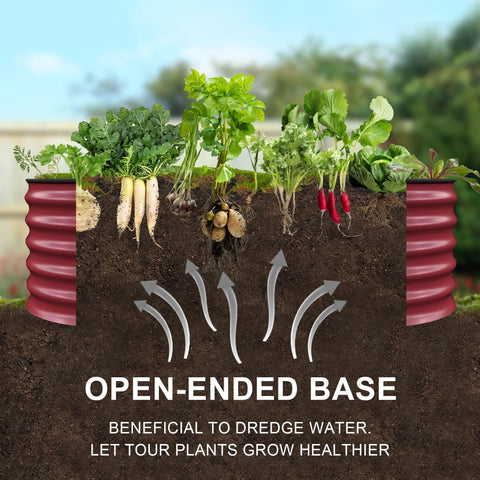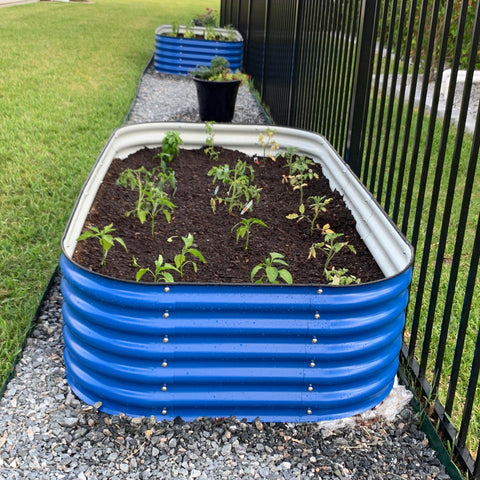Tips from Olle Raised Bed Garden Success
Raised bed gardening may be the answer you've been looking for if you love to garden but are constrained by a lack of space or poor soil quality. Raised bed gardens have many benefits, including improved soil management, improved drainage, and low maintenance requirements. This blog will give you helpful advice and insights to make sure your raised bed garden thrives, whether you're an experienced gardener or a beginner looking to try your hand at creating a green paradise.
Choosing the Right Location
Before you start building your raised bed garden, it's essential to select the right location. Here are some factors to consider:
Sunlight: The majority of plants, including vegetables and flowers, need at least 6 to 8 hours of direct sunlight each day. Pick a location that gets plenty of light all day.
Accessibility: Ensure your raised bed is easily accessible for planting, watering, and harvesting. You don't want to trek through mud or struggle with heavy equipment.
Proximity to Water: Place your raised bed near a water source to make watering more convenient. Installing a drip irrigation system can also save time and ensure consistent moisture.
Soil Quality: Assess the soil quality in the chosen area. Raised beds allow you to fill them with the ideal soil mix, but if your site has poor drainage, it may require additional attention.

Building Your Raised Bed
Once you've chosen the perfect location, it's time to construct your raised bed. Here's how to do it:
Materials: You can use various materials, including wood, concrete blocks, or even recycled materials like old tires or pallets. Ensure the chosen material is non-toxic and won't leach harmful chemicals into your soil.
Size: Keep the width of your raised bed between 3 to 4 feet, as this allows you to reach the center comfortably without stepping into the bed. The length can change based on the amount of room.
Height: A typical height for raised beds is 12 to 24 inches. Taller beds are more accessible for people with mobility issues.
Leveling: Ensure the base of your raised bed is level to prevent uneven water distribution. Use a level and a tape measure to achieve this.
Selecting the Right Soil Mix
One of the key factors that contribute to the success of a raised bed garden is the soil mix you use. Unlike traditional in-ground gardens, where you may need to work with your existing soil, raised beds offer the advantage of complete control over your garden's growing medium. In this blog post, we will explore the importance of selecting the right soil mix for your raised bed garden and provide guidance on how to create the ideal blend for your plants to thrive.
Why the Right Soil Mix Matters
Drainage and Aeration: The soil mix in your raised bed must have proper drainage and aeration to prevent waterlogging. Good drainage ensures that your plants' roots do not suffocate, while adequate aeration allows them to access oxygen.
Nutrient Retention: The soil mix should retain essential nutrients, ensuring your plants have access to the minerals and trace elements they need for healthy growth.
pH Balance: The pH level of your soil mix affects nutrient availability to plants. Different plants have different pH preferences, so your soil mix should align with what you plan to grow.
Weed and Pest Control: A well-structured soil mix can also help deter weeds and some garden pests, reducing the need for constant maintenance and pest control efforts.
Now that we understand why the right soil mix is essential let's delve into how to select and create the perfect blend.

Choosing the Right Ingredients
Topsoil: High-quality topsoil is the foundation of your raised bed garden. It ought to be nutrient- and organic-rich. You can purchase screened topsoil or use your own if it's suitable.
Compost: Compost adds valuable organic matter and nutrients to your soil mix. It improves both water retention and drainage. You can make your compost or buy it from a garden center.
Peat Moss or Coconut Coir: These materials help retain moisture in your soil mix, ensuring your plants have a consistent source of water. Peat moss is acidic, so consider your pH requirements when choosing between the two.
Perlite or Vermiculite: These additives improve aeration and drainage. They also help prevent soil compaction, which can be a problem in raised beds.
Fertilizers: Consider adding slow-release organic fertilizers to provide a steady supply of nutrients throughout the growing season. Alternatively, you can use composted manure or worm castings for a nutrient boost.
Creating the Ideal Mix
It's time to combine your ingredients now that you have them. Here's a basic recipe for a raised bed soil mix:
50% Topsoil
30% Compost
10% Peat Moss or Coconut Coir
10% Perlite or Vermiculite
Mix these ingredients thoroughly in a wheelbarrow or on a tarp. Be sure to break up any clumps and create a consistent blend. Once your mix is ready, fill your raised bed with it, leaving about an inch or two of space at the top for mulch or additional compost.
Maintaining Your Soil Mix
Your work doesn't end once your raised bed is filled with the perfect soil mix. Here are some recommendations for keeping it:
Mulch: Apply a layer of mulch on top of your soil to help retain moisture and regulate soil temperature.
Regular Testing: Periodically test your soil's pH and nutrient levels to ensure it meets your plants' requirements.
Crop Rotation: Rotate your crops each season to prevent soil depletion of specific nutrients.
Compost and Fertilize: Add compost and fertilizers as needed to replenish nutrients throughout the growing season.

Planting and Maintenance
With your raised bed ready, it's time to plant and maintain your garden. Here's what you need to know:
Plant Spacing: Follow recommended spacing guidelines for each type of plant to prevent overcrowding.
Mulching: Apply mulch to help retain moisture, suppress weeds, and regulate soil temperature.
Regular Watering: Monitor soil moisture and water consistently. Raised beds can dry out more quickly, so a drip irrigation system or soaker hose can be beneficial.
Weeding: Keep an eye out for weeds and remove them promptly to prevent competition for nutrients.
Crop Rotation: To prevent soil depletion and pest buildup, rotate your crops each season.
Pest and Disease Control: Implement natural pest control methods, such as companion planting or organic pesticides, to protect your plants.
Harvesting: Harvest your crops at their peak of ripeness for the best flavor and nutrition.
Raised bed gardening offers an efficient and productive way to cultivate your own green paradise, even in limited spaces or challenging soil conditions. By choosing the right location, constructing a sturdy bed, creating a nutrient-rich soil mix, and following best practices for planting and maintenance, you'll be well on your way to enjoying a flourishing raised bed garden. So, roll up your sleeves, put on your gardening gloves, and start building your green thumb's paradise today!
